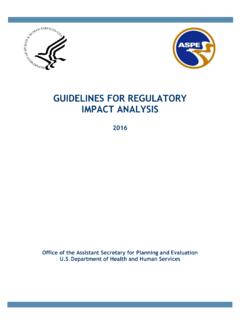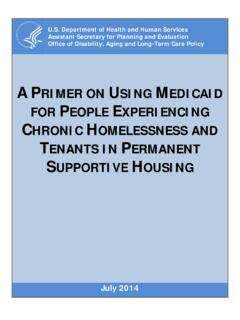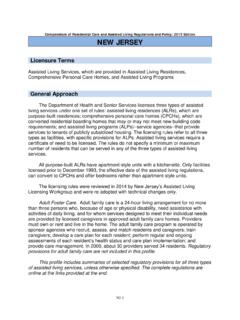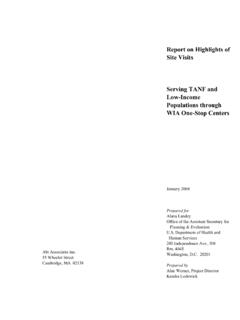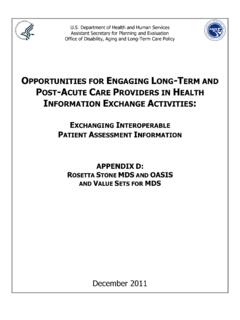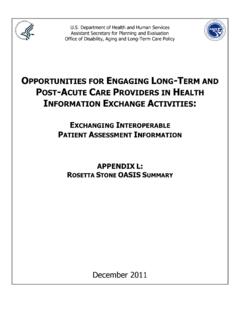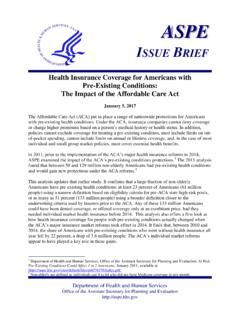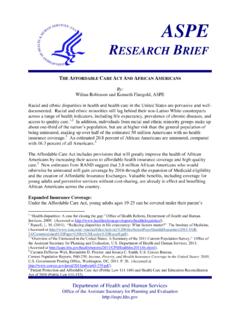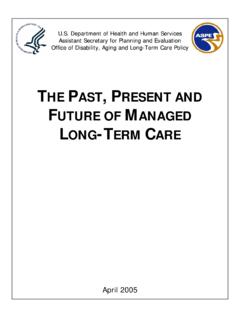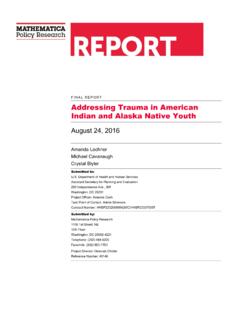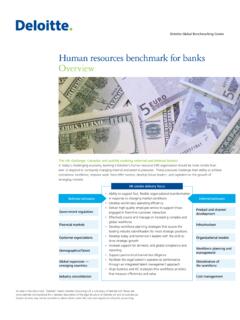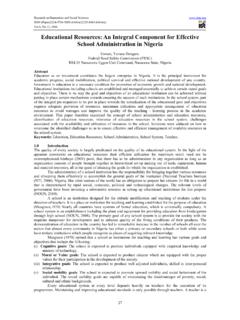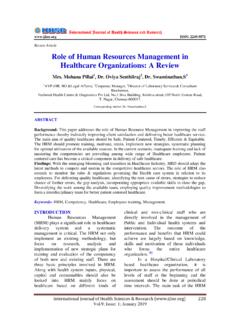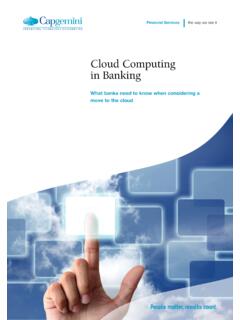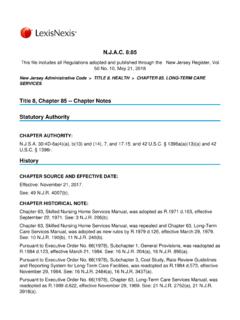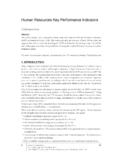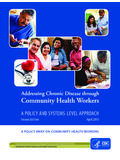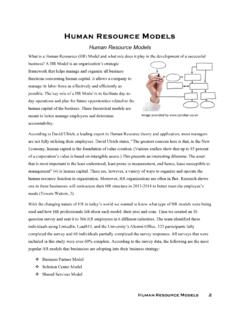Transcription of Trends in the Utilization of Emergency Department Services ...
1 Trends in the Utilization of Emergency Department Services , 2009-2018 March 2, 2021 Department of Health and human Services Office of the Assistant Secretary for Planning and Evaluation R E P O R T T O C O N G R E S S March 2021 REPORT TO CONGRESS 1 The Office of the Assistant Secretary for Planning and Evaluation The Assistant Secretary for Planning and Evaluation (ASPE) advises the Secretary of the Department of Health and human Services (HHS) on policy development in health, disability, human Services , data, and science; and provides advice and analysis on economic policy. ASPE leads special initiatives; coordinates the Department 's evaluation, research, and demonstration activities; and manages cross- Department planning activities such as strategic planning, legislative planning, and review of regulations.
2 Integral to this role, ASPE conducts research and evaluation studies; develops policy analyses; and estimates the cost and benefits of policy alternatives under consideration by the Department or Congress. The Office of Health Policy The Office of Health Policy (HP) provides a cross-cutting policy perspective that bridges Departmental programs, public and private sector activities, and the research community, in order to develop, analyze, coordinate and provide leadership on health policy issues for the Secretary. HP carries out this mission by conducting policy, economic and budget analyses, assisting in the development and review of regulations, assisting in the development and formulation of budgets and legislation, and assisting in survey design efforts, as well as conducting and coordinating research, evaluation, and information dissemination on issues relating to health policy.
3 Suggested Citation Office of the Assistant Secretary for Planning and Evaluation, Department of Health & human Services . Trends in the Utilization of Emergency Department Services , 2009-2018. 2021. Acknowledgements ASPE gratefully acknowledges staff in the Agency for Healthcare Research and Quality that provided data and assistance with interpretation of results for this report. March 2021 REPORT TO CONGRESS 2 Table of Contents The Office of t he Assistant Secretary for Pla nning a nd Eva luat ion .. 1 The Office of Hea lth Policy .. 1 Suggested 1 Acknow ledge ments .. 1 3 Section 1: Introduction .. 4 Key Data Trends : 2009-2018 .. 8 Section 2: Categorizing Ut ilization of Emerge ncy Departme nts.
4 11 Section 3: Data on Utilization of E merge ncy Departme nts ..14 Section 4: Results of Ana lys is on Emergenc y De partme nt Ut ilizat ion ..17 National Trends ..18 Patient Characteristics ..19 Hospital and Community Characteristics ..22 Payer Trends ..24 Geographic Trends ..29 Hospital Type ..31 Diagnoses ..32 Section 5: Efforts t o Disc ourage Overuse of Emergenc y De partme nts ..34 Centers for Medicare & Medicaid Substance Abuse and Mental Health Services Administration ..39 Urgent Care Centers, Retail Clinics, and Health Centers ..39 Section 6: Conc lus ions ..41 Appe ndix ..44 Data Sources ..44 HCUP NEDS, SID, and SEDD ..44 CDC Social Vulnerability Index ..47 Supplementary Tables and Sample of Rece nt Reports on ED Utilization from HHS.
5 57 Agency for Healthcare Research and Quality - Agency for Healthcare Research and Quality Medical Expenditures Panel Survey ..57 Centers for Disease Control and Prevention ..57 References ..59 March 2021 REPORT TO CONGRESS 3 Acronyms AHC Accountable Health Communities AHRQ Agency for Healthcare Research and Quality ASPE Office of the Assistant Secretary for Planning and Evaluation CCS Clinical Classification Software CCSR Clinical Classification Software Refined CDC Centers for Disease Control and Prevention CMS ED Centers for Medicare & Medicaid Services Emergency Department EMS EMTALA Emergency medical Services Emergency Medical Treatment & Labor Act ET3 Emergency Triage, Treat, and Transport model FFS Fee-for-service HCUP Healthcare Cost and Utilization Project HHS Department of Health and human Services MACPAC Medicaid and CHIP Payment and Access Commission NCHS National Center for Health Statistics NHCS National Health Care Survey NEDS Nationwide Emergency Department Sample SEDD State Emergency Department Databases SID State Inpatient Databases SVI Social Vulnerability Index March 2021 REPORT TO CONGRESS 4 Section 1: Introduction March 2021 REPORT TO CONGRESS 5 Introduction This Report to Congress responds to the Joint Explanatory Statement Regarding 1865, the Further Consolidated Appropriations Act, 2020.
6 Emergency Room Utilization HHS is encouraged to submit a report that analyzes Emergency room Utilization at the State and national levels to be provided to the Committees no later than one year after enactment of this Act. The report should focus on non- Emergency Services while in the Emergency room Potential overuse or inappropriate use of Emergency departments (EDs) for non-emergent care has been a concern for many years. EDs are a large and important component of the health care system in the United States, both in terms of number of patients served and spending. Overall, there were over 143 million ED visits in 2018, and of these, more than 20 million ended in admission to the same hospital while over 123 million ended in a release (HCUP NEDS 2018).
7 In 2017, over 18% of adults reported having visited an ED at least once in the past year (NCHS 2018). One analysis suggests ED visits accounted for approximately ($ billion) of overall national health expenditures in 2010. Although treat-and-release visits make up the majority of ED visits, they are less expensive on average, accounting for an estimated of the of national health expenditures, compared with for ED visits ending in admission (Galarraga and Pines 2016). The estimated average cost2 of a visit (not adjusted for complexity of care) to the ED in the United States was $530 in 2017, although this was higher for patients with Medicare as an expected payer ($660 per visit), and those with private insurance as an expected payer ($560 per visit) and lower for patients with Medicaid as expected payer ($420 per visit) and those with self-pay or no charge ($460 per visit) (Karaca and Moore 2020).
8 The average cost of care for approximately comparable conditions appears to be much higher in an ED (some estimates are as high as 10-12 times higher) compared to care provided in an urgent clinic or physician office (UnitedHealth Group 2019; Ho et al. 2017). Estimates indicate that almost all spending growth for Emergency room Services reimbursed by commercial insurers in recent years has been driven by price increases, particularly for high-severity conditions, as opposed to Utilization growth (Health Care Cost Institute 2018). A particular area of concern with regards to ED capacity has been reliance on the ED by many patients for mental health/SUD treatment and related challenges. Providing treatment for such patients can be complex and resource intensive and when hospitalization is required there are not always sufficient beds in hospitals for these patients.
9 Individuals seek care in the ED for a wide variety of reasons, including problems with access to Services in other settings as well as the challenge of determining the urgency of symptoms such as chest or abdomen pain without further diagnostics. This may be part of the reason that despite a number of efforts meant to discourage use of the ED when care might be better provided elsewhere, often by a primary care provider, there is little evidence to suggest these efforts are having a sizable impact. This report analyzes 10 years of ED Utilization data from the Department of Health and human Services (HHS) Agency for Healthcare Research and Quality (AHRQ), from 2009-2018 at the national 1 Joint Explanatory Statement Regarding 1865, the Further Consolidated Appropriations Act, 2020, signed into law December 20, 2019, p.
10 119. See 2 Costs are estimated from charges by applying an average cost-to-charge ratio constructed for each hospital. March 2021 REPORT TO CONGRESS 6 level and the state level (where possible). The current COVID-19 pandemic impacted most aspects of the health care delivery system in 2020 in different ways in different settings. Analyses of ED Utilization in the early months of the pandemic have shown that ED visits declined dramatically. Estimates from the Centers for Disease Control, for instance, suggested ED visits declined by 42% between late March 2020 to late April 2020 and there were smaller though still substantial declines even for life-threatening conditions such as myocardial infarction, stroke, and hyperglycemic crisis, suggesting individuals may have been avoiding or unable to access care even in cases where the need was urgent (Lange et al.)
